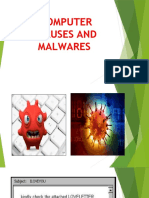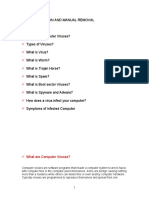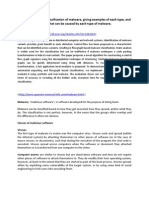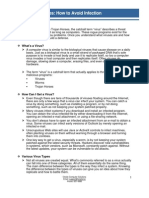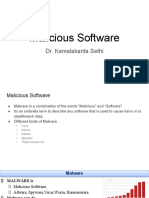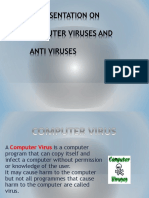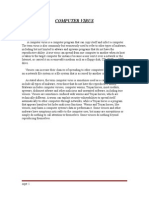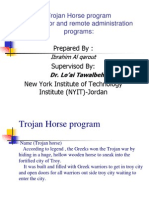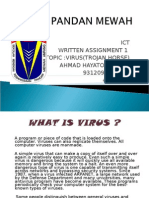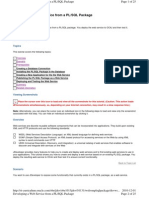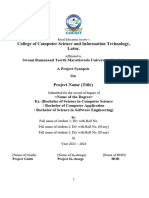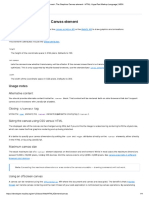Internet and Networks Attacks
Internet and Networks Attacks
Uploaded by
faaizaCopyright:
Available Formats
Internet and Networks Attacks
Internet and Networks Attacks
Uploaded by
faaizaOriginal Description:
Copyright
Available Formats
Share this document
Did you find this document useful?
Is this content inappropriate?
Copyright:
Available Formats
Internet and Networks Attacks
Internet and Networks Attacks
Uploaded by
faaizaCopyright:
Available Formats
INTERNET AND NETWORKS ATTACKS Computer Viruses, Worms and Trojan Horses
Unscrupulous programmers write malware and then test it to ensure it can deliver its payload. The payload is the destructive event or prank the program is intended to deliver.
MALWARE (MALICIOUS PROGRAM) Malware are programs that act without a users knowledge and deliberately alter the computers operations. Computer viruses, worms, and Trojan horses are classified as malware.
Computer Viruses is a potentially damaging computer program that affects, or infects, a computer negatively by altering the way the computer works without the users knowledge or permission. Once the virus infects the computer, it can spread throughout and may damage files and system software, including the operating system.
A worm is a program that copies itself repeatedly, for example in memory or on a network, using up resources and possibly shutting down the computer or network.
A Trojan horse (named after the Greek myth) is a program that hides within or looks like a legitimate program. A certain condition or action usually triggers the Trojan horse. Unlike a virus or worm, a Trojan horse does not replicate itself to other computers.
TIPS FOR PREVENTING VIRUS, WORM, AND TROJAN HORSE INFECTIONS Never start a computer with removable media inserted in the drives or plugged in the ports, unless the media is uninfected. Never open an e-mail attachment unless you are expecting it and it is from a trusted source. Turn off message preview. Install an antivirus program on all of your computers. Obtain updates to the virus signature files on a regular basis. Check all downloaded programs for viruses, worms, or Trojan horses. This malware often is placed in seemingly innocent programs, so it will affect a large number of users. If the antivirus program flags an e-mail attachment as infected, delete the attachment immediately. Before using any removable media, use the antivirus scan program to check the media for infection. Install a personal firewall program.
A computer infected by a virus, worm, or Trojan horse often has one or more of the following symptoms : Screen displays unusual message or image Music or unusual sound plays randomly Available memory is less than expected Existing programs and files disappear Files become corrupted Programs or files do not work properly Unknown programs or files mysteriously appear System properties change
SPAM Unwanted or junk e-mail. The spammers get your e-mail whenever you used your email address to purchase anything online or to open an online account, or if youve participated in a newsgroup or a chat room.
COOKIES Small text files that some Web sites automatically store on your computers hard drive when you visit the Web site. It assign unique ID number for your computer to make your return visit to the Web site more efficient to your interest because it can keeps tracks from its database.
Shelly C.V (2007). Discovering Computers. Boston : Thomson Course Technology. Alan Evans, Kendall Martin & Mary A.P (2008). Technology in Action. New Jersey : Pearson Prentice Hall.
You might also like
- Project Report - E-Shopping For ClothesDocument11 pagesProject Report - E-Shopping For ClothesManish misal100% (2)
- Company Profile SOD and EsportshubDocument16 pagesCompany Profile SOD and EsportshubIfa HanifahNo ratings yet
- Computer Viruses and MalwaresDocument76 pagesComputer Viruses and MalwaresHazel Karen CaguinginNo ratings yet
- Day - 1Document19 pagesDay - 1Sivakumar RavichandranNo ratings yet
- VirusDocument17 pagesVirusjobyannabonitoNo ratings yet
- AllaboutcomputermalwaresDocument8 pagesAllaboutcomputermalwaresRIZALINA BATANNo ratings yet
- Computer VirusDocument11 pagesComputer VirusAbhay AnantNo ratings yet
- Lesson 4.1 MalwaresDocument19 pagesLesson 4.1 Malwares7m5nr5hfmcNo ratings yet
- The Difference Between A Virus, Worm and Trojan HorseDocument4 pagesThe Difference Between A Virus, Worm and Trojan Horseneyoze100% (1)
- Final ThesisDocument18 pagesFinal ThesisBelen Rosario78% (9)
- Ethical Hacking - 5 - 1713781468143Document26 pagesEthical Hacking - 5 - 1713781468143cocshravan69No ratings yet
- Virus and TrojansDocument3 pagesVirus and TrojansSaiful KaderNo ratings yet
- Malware: Online Threats: Presented By: Ramil L. Kaharian ICT TeacherDocument16 pagesMalware: Online Threats: Presented By: Ramil L. Kaharian ICT TeacherShielina Mae CosejoNo ratings yet
- Lesson 9 Computer VirusesDocument47 pagesLesson 9 Computer Virusesgardomaset6No ratings yet
- Computer ProjectDocument6 pagesComputer ProjectPiyush RanjanNo ratings yet
- Definition of VirusDocument3 pagesDefinition of Virusunknown.JackNo ratings yet
- Wk01 - Mind MapDocument1 pageWk01 - Mind MapJamesNo ratings yet
- Duyhien Phan2Document2 pagesDuyhien Phan2Tùng Trần ThanhNo ratings yet
- Cyber SecurityDocument2 pagesCyber Securitymanipritam87No ratings yet
- Virus Worms TrojenhorseDocument3 pagesVirus Worms TrojenhorseAltaf KarediaNo ratings yet
- Project Report On Computer VirusDocument11 pagesProject Report On Computer Virusmithun379050% (4)
- CLI Unit2Document17 pagesCLI Unit2homeserv123No ratings yet
- Internet Security NotesDocument7 pagesInternet Security Notescool.tbaNo ratings yet
- Virus Definition and Manual RemovalDocument6 pagesVirus Definition and Manual RemovalJerrymae OboNo ratings yet
- AbstractDocument24 pagesAbstractVijay Kumar0% (1)
- Mal WaresDocument12 pagesMal WaresXA18 Pankti Kamlesh PatelNo ratings yet
- Malware Classification & DamagesDocument7 pagesMalware Classification & Damagesnusha2907No ratings yet
- Computer Viruses: How To Avoid InfectionDocument6 pagesComputer Viruses: How To Avoid Infection22shimmer22No ratings yet
- CSS expPPT 06 07 35 42Document18 pagesCSS expPPT 06 07 35 42TANUSHRI DASNo ratings yet
- Virus and Its TypesDocument7 pagesVirus and Its TypesrajNo ratings yet
- Computer Malware ConsolidatedDocument4 pagesComputer Malware ConsolidatedbardiavivaanNo ratings yet
- Computer VirusDocument14 pagesComputer Virussouviks.phd18.ecNo ratings yet
- Malware-Class 11Document19 pagesMalware-Class 11cuteff24No ratings yet
- CISCODocument12 pagesCISCOjunomarsNo ratings yet
- What Is A Computer VirusDocument14 pagesWhat Is A Computer VirusJohn YohansNo ratings yet
- Module 5and6Document26 pagesModule 5and6JAYANTH KORRANo ratings yet
- CH # 5 VirusesDocument11 pagesCH # 5 VirusesM.Zaman MughalNo ratings yet
- Mal WareDocument13 pagesMal Warenarinesinghkatrina007No ratings yet
- Malware: Major Ethical IssuesDocument12 pagesMalware: Major Ethical IssuesSutej RajputNo ratings yet
- Naman PPT Computer VirusDocument23 pagesNaman PPT Computer VirusSagar KadyanNo ratings yet
- What Is A Computer Virus and How Can I Protect My ComputerDocument4 pagesWhat Is A Computer Virus and How Can I Protect My ComputerObedient KachecheNo ratings yet
- Introduction To Computer: Semester: BS 5 Environmental SciencesDocument22 pagesIntroduction To Computer: Semester: BS 5 Environmental Sciencesrida faizNo ratings yet
- Security Threats in E-ComDocument27 pagesSecurity Threats in E-ComUzair AmirNo ratings yet
- 2 - Common Malware Types and SymptomsDocument6 pages2 - Common Malware Types and SymptomsKashif KamalNo ratings yet
- Security ThreatsDocument10 pagesSecurity ThreatsKabir SinghNo ratings yet
- 2.3network SecurityDocument22 pages2.3network Securitybrought to inspire - faith silvaNo ratings yet
- Computer Viruses Types of Viruses Use of Antivirus - WPS OfficeDocument6 pagesComputer Viruses Types of Viruses Use of Antivirus - WPS OfficeMai Cres Brazil CrescencioNo ratings yet
- Project ReportDocument6 pagesProject Reportsharrmaa0% (1)
- Computer Viruses and Antiviruses: Presented To: Raj Kumar Tandulkar Computer Teacher of Class "10"Document18 pagesComputer Viruses and Antiviruses: Presented To: Raj Kumar Tandulkar Computer Teacher of Class "10"Davy jonesNo ratings yet
- ch 2 a&sDocument7 pagesch 2 a&sendesh manNo ratings yet
- Trojan BackdoorsDocument32 pagesTrojan BackdoorsSneha VermaNo ratings yet
- History of Computer VirusDocument15 pagesHistory of Computer VirusEARL JAMES YONSONNo ratings yet
- Assignment ICT ! DesignDocument10 pagesAssignment ICT ! DesignjamelyNo ratings yet
- Trojan Horse: Computer Viruses Typically Attach To An Executable Host FileDocument3 pagesTrojan Horse: Computer Viruses Typically Attach To An Executable Host FileReena CorreaNo ratings yet
- What Is Virus (Introduction)Document9 pagesWhat Is Virus (Introduction)Miniski NexNo ratings yet
- Computer Virus and Anti VirusDocument49 pagesComputer Virus and Anti VirusJay Smith100% (3)
- Virus Worm TrojanDocument3 pagesVirus Worm TrojanCatdog CatNo ratings yet
- Threats To Sys SecurityDocument3 pagesThreats To Sys SecurityPoornima SinghNo ratings yet
- MalwareDocument10 pagesMalwareAbdul Achukatla SaleemNo ratings yet
- Virus, Worms and TrojansDocument1 pageVirus, Worms and Trojansاحتشام چوہدریNo ratings yet
- Virus, Worms and TrojansDocument1 pageVirus, Worms and Trojansاحتشام چوہدریNo ratings yet
- Transitive Verbs PresentDocument8 pagesTransitive Verbs PresentfaaizaNo ratings yet
- InterruptionandTurn TakingDocument11 pagesInterruptionandTurn TakingfaaizaNo ratings yet
- Illegal Racing Among Teenagers PPDocument7 pagesIllegal Racing Among Teenagers PPfaaizaNo ratings yet
- PoemDocument11 pagesPoemfaaizaNo ratings yet
- (PassLeader) Microsoft 70-411 301q Exam Dumps (PDF) (141-160)Document15 pages(PassLeader) Microsoft 70-411 301q Exam Dumps (PDF) (141-160)MaheshKumarNo ratings yet
- Log Cat 1687823768852Document2,648 pagesLog Cat 1687823768852Akbar PrasNo ratings yet
- Creating New Web Service Using PLSQL PackageDocument25 pagesCreating New Web Service Using PLSQL PackagesarangiabhayaNo ratings yet
- AWS Storage OptionsDocument34 pagesAWS Storage OptionsSatyajeet Vishwakarma100% (1)
- Reynolds - Latin Reader-Nature Study and Easy Stories For Sight Reading During The First Year in Latin PDFDocument399 pagesReynolds - Latin Reader-Nature Study and Easy Stories For Sight Reading During The First Year in Latin PDFMATÍAS ZúñigaNo ratings yet
- Project Synopsis 2023 24 UGDocument9 pagesProject Synopsis 2023 24 UGjujubershaikh36No ratings yet
- Aws 202204Document6 pagesAws 202204Mori YuNo ratings yet
- Software Development ModelsDocument20 pagesSoftware Development ModelsMonika PuriNo ratings yet
- Virtual Reality and Augmented RealityDocument8 pagesVirtual Reality and Augmented RealityarumughamthanuNo ratings yet
- Canvas - The Graphics Canvas Element - HTML - HyperText Markup Language - MDNDocument4 pagesCanvas - The Graphics Canvas Element - HTML - HyperText Markup Language - MDNBrubaker BrubakeNo ratings yet
- Universal McCann Wave2Document15 pagesUniversal McCann Wave2GeekyGrrrl100% (3)
- PVS AcceleratorDocument10 pagesPVS AcceleratorMABUSUBANI SHAIKNo ratings yet
- AARIFDocument16 pagesAARIFduttavibhor01No ratings yet
- Guide How to Perform YouTube Video OptimizationDocument15 pagesGuide How to Perform YouTube Video Optimizationshoaibatif0009No ratings yet
- Service Report - Fields That Upload To DBSDocument17 pagesService Report - Fields That Upload To DBSZIBA KHADIBINo ratings yet
- INNOVATIVE PROJECT On PORTFOLIODocument14 pagesINNOVATIVE PROJECT On PORTFOLIONeha SinghNo ratings yet
- LetterDocument1 pageLetterACABNo ratings yet
- November Revision Primary 4 (ICT Primary 4)Document5 pagesNovember Revision Primary 4 (ICT Primary 4)moka.moka22448810No ratings yet
- Human Computer Interaction and Communication: Assessment 05Document2 pagesHuman Computer Interaction and Communication: Assessment 05Felipe RosalesNo ratings yet
- GPU - Video Card (Display, Graphic, VGA)Document38 pagesGPU - Video Card (Display, Graphic, VGA)Akhila DakshinaNo ratings yet
- Pipe SaddleDocument1 pagePipe SaddledNo ratings yet
- Administration PostgreSQLDocument109 pagesAdministration PostgreSQLAlmase50% (2)
- Google Cloud Developer's Cheat Sheet v2018.9.14Document1 pageGoogle Cloud Developer's Cheat Sheet v2018.9.14Anonymous Ue1lY0hNo ratings yet
- Wintool Esprit Interface eDocument23 pagesWintool Esprit Interface eVagner Aux CadNo ratings yet
- Ahoy ThereDocument55 pagesAhoy ThereferrariaceNo ratings yet
- Android Guide With Imtiaz Saifullah: Email: Ping/Text: +92-331-7370872Document11 pagesAndroid Guide With Imtiaz Saifullah: Email: Ping/Text: +92-331-7370872Ali Hassan NaqviNo ratings yet
- Adobe Zii 402 PDFDocument3 pagesAdobe Zii 402 PDFNajeeNo ratings yet
- Gazepoint AnalysisDocument12 pagesGazepoint AnalysispichrNo ratings yet


